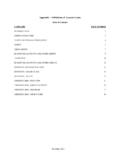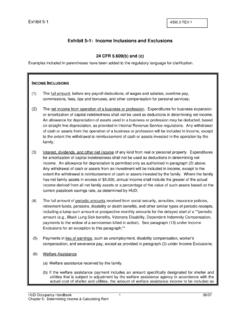Transcription of Sample Rules for Electronic Meetings
1 Page 1 of 11 Sample Rules for Electronic Meetings By Henry M. Robert III, Daniel H. Honemann, Thomas J. Balch, Daniel E. Seabold, and Shmuel Gerber, authors of Robert s Rules of Order Newly Revised Introduction As noted in Robert s Rules of Order Newly Revised,* there is an increasing preference among some organizations to transact business at Electronic Meetings , in which some or all of the members communicate through Electronic means such as the Internet or by telephone. Regarding the proper authorization of such Meetings , and their limitations, please refer to the subsection entitled Electronic Meetings [RONR (11th ed.), pp. 97 99], wherein it is stated that when Electronic Meetings are authorized which, in the case of a board or other assembly, always requires a bylaw provision additional Rules should be adopted to govern their conduct.
2 Depending on the nature of the Rules and the specific provisions of the bylaws, such additional Rules may be placed in the bylaws, adopted as special Rules of order or standing Rules , or contained in instructions from a superior body. The additional Rules appropriate to a particular organization s Electronic Meetings may depend on many factors, such as the number of members in the organization, the nature and complexity of the business to be transacted, the organization s need for confidentiality in its * This title is commonly abbreviated as RONR. The Twelfth Edition of Robert s Rules of Order Newly Revised is scheduled for publication in September 2020 by PublicAffairs, and is available now for preorder: Preorder now Page 2 of 11 proceedings, and the funds available.
3 Four sets of Sample Rules for Electronic Meetings designed to meet various needs are provided here, along with bylaw provisions sufficient to authorize such Meetings . These Rules should, of course, be adapted as necessary for the particular circumstances of each group and the technology the organization finds most useful. It is therefore advisable to review all four sets of Rules , as some particular Rules from one set may prove appropriate for adaptat ion together with some or all of the Rules from another. It is also worth noting that although the Rules below are written on the assumption they would be used by a board, RONR (11th ed.), pp. 97, 98, recognizes that Electronic Meetings could be authorized for another type of assembly or for a committee, and the Sample Rules could be adapted accordingly.
4 Consider an organization governed by bylaws whose relevant provisions are patterned directly on the Sample Bylaws in Robert s Rules of Order Newly Revised. Each of the four sets of Sample Rules below shows how the organization might amend Article VI of the bylaws [RONR (11th ed.), pp. 586 87] to authorize the executive board to conduct business by a particular type of Electronic meeting. In each case, the Sample bylaw provisions are followed by a number of additional Rules that may be helpful in governing the conduct of that type of meeting. The Sample Rules in Scenarios A, B, C, and D below are designed for allowing the board to make use of the following types of Electronic communication to conduct Meetings , respectively: A.
5 Full-featured Internet, or combination Internet/telephone, meeting services that integrate audio (and optionally video), text, and voting capabilities. B. Telephone Meetings , with Internet services for conducting secret votes and sharing documents. C. A speakerphone in the meeting room to allow members who are not physically present to participate by telephone. D. Telephone Meetings without Internet support (and without any central meeting room). For Scenarios A and B, it is assumed that Electronic Meetings will be the usual method for conducting business, with in-person Meetings held only when ordered by the board or all of its members. In Scenario C, it is assumed that a physical meeting space is designated for every meeting, but individual board members may participate by telephone.
6 In Scenario D, in-person Meetings are assumed as the norm, but telephone Meetings may be ordered as needed. Scenario A: Use of Full-Featured Internet Meeting Services In this scenario, the board makes use of Internet meeting services with integrated audio (and optionally video), text, and voting capabilities as the usual meeting method, with in-person Meetings when ordered by the board or all of its members. Internet meeting services adapted to the needs of deliberative assemblies vary somewhat in the names given to their features and in how they are set up and arranged. Typically, a Page 3 of 11 full-featured Internet meeting is set up as follows: Each participant, using his or her own computer or other device, can view the current list of all participants with an indication of which member has the floor or which members are seeking recognition by the chair and can seek recognition, submit motions in writing, view the text of pending motions, vote, and view the results of a vote.
7 The Sample Rules given below require that anonymous voting be supported (in other words, that a member who is properly logged in to a meeting can cast an Electronic ballot that does not identify that member s vote as belonging to him or her), and they also assume that non-anonymous votes can be taken, as well. Audio transmissions can be integrated directly via the Internet, so that participants listen and speak through microphones and speakers or headsets at their computers or other devices. Alternatively, there might be a conference call, with access codes for the participants, that is dialed into by ordinary telephone but is also linked to the Internet meeting interface, so that participants speak and listen by telephone, but use the Internet service (which remains aware of the identity of each caller) for all other features.
8 If the participants have webcams for transmitting live video, a portion of the screen might show their faces, or else (perhaps depending on the total number of participants) just those of the chair and/or the person speaking in debate or presenting a report. The organizers of the meeting also have access to a control panel for use by the chair, the Recording Secretary, and their assistants, which enables them to perform their duties during the meeting, such as ensuring that the text of the pending question is properly displayed, assigning the floor to a member, opening and closing the polls for taking a vote, controlling the camera view, etc. Assuming an organization s bylaws are patterned directly on the Sample Bylaws in Robert s Rules of Order Newly Revised, the organization can authorize the board to meet by use of an Internet meeting service with features like those described above by adding the following sections to Article VI [RONR (11th ed.)]
9 , pp. 586 87]: Sample Bylaw Provisions for Scenario A Section 4. Meetings Held Electronically. Except as otherwise provided in these bylaws, Meetings of the Board shall be conducted through use of Internet meeting services designated by the President that support anonymous voting and support visible displays identifying those participating, identifying those seeking recognition to speak, showing (or permitting the retrieval of) the text of pending motions, and showing the results of votes. These Electronic Meetings of the Board shall be subject to all Rules adopted by the Board, or by the Society, to govern them, which may include any reasonable limitations on, and requirements for, Board members participation.
10 Any such Rules adopted by the Board shall supersede any conflicting Rules in the parliamentary authority, but may not otherwise conflict with or alter any rule or decision of the Society. An anonymous vote conducted through the designated Internet meeting service shall be deemed a ballot vote, fulfilling any requirement in the bylaws or Rules that a vote be conducted by ballot. Section 5. Meetings Held in Person. Some particular meeting or Page 4 of 11 Meetings of the Board shall be held in person either (a) when the President or First Vice-President has obtained written consent for this from every Board member, or (b) when ordered by the Board, by a two-thirds vote with previous notice of a motion to do so having been given.









